Introduction to privacy enhancing technologies (PET)
Last updated on 2024-11-19 | Edit this page
Overview
Questions
- What techniques exist for analyzing data while protecting privacy?
- What are issues with only using data anonymization or pseudonymization?
- What are the building blocks to create a privacy enhancing analysis?
- What what are some non-technical challenges for performing privacy enhancing analysis?
Objectives
- Understand PET, FL, MPC, homomorphic encryption, differential privacy
- Understand how different PET techniques relate
- Understand scenarios where PET could be applied
- Understand horizontal vs vertical partitioning
- Decompose a simple analysis in a federated way
- Understand that there is paperwork to be done (DPIA etc.)
Introduction
In this course, we will explore how privacy-enhancing technologies (PETs) can support your research. On the first day, we will cover some of the core concepts of PET analysis, followed by a hands-on session where we’ll apply these techniques using the vantage6 user interface. We will also discuss how to manage PET analysis collaborations, one of the vantage6’s key distinguising features.
In the second part of the workshop, we will focus on the python client, which can do the same as the UI, but also much more. You will also learn how to create a federated algorithm using the platform’s algorithm tools.
This course provides a high-level overview of PETs, focusing on their practical applications in data analysis. While we won’t dive into the detailed mathematics behind these technologies, we encourage you to explore other resources for those specifics. Our goal here is to equip you with enough knowledge to apply PETs effectively in your work.
Problem statement
The amount of data being generated nowadays is absolutely mind-boggling. This data can be a valuable resource for researchers. However, personal data should be handled with great care and responsibility because of its sensitive nature. This is why there are privacy regulations in place like GDPR to prohibit easy access to this wealth of data.
However, often researchers are not interested in the personal records that make up the data, but rather in the insights derived from it. This raises an intriguing question: Can we unlock these valuable insights in a manner that upholds and respects privacy standards?
In classic data analysis, all data is copied over into a single place. This makes it very easy to use conventional data analysis software and tools to gain insights.
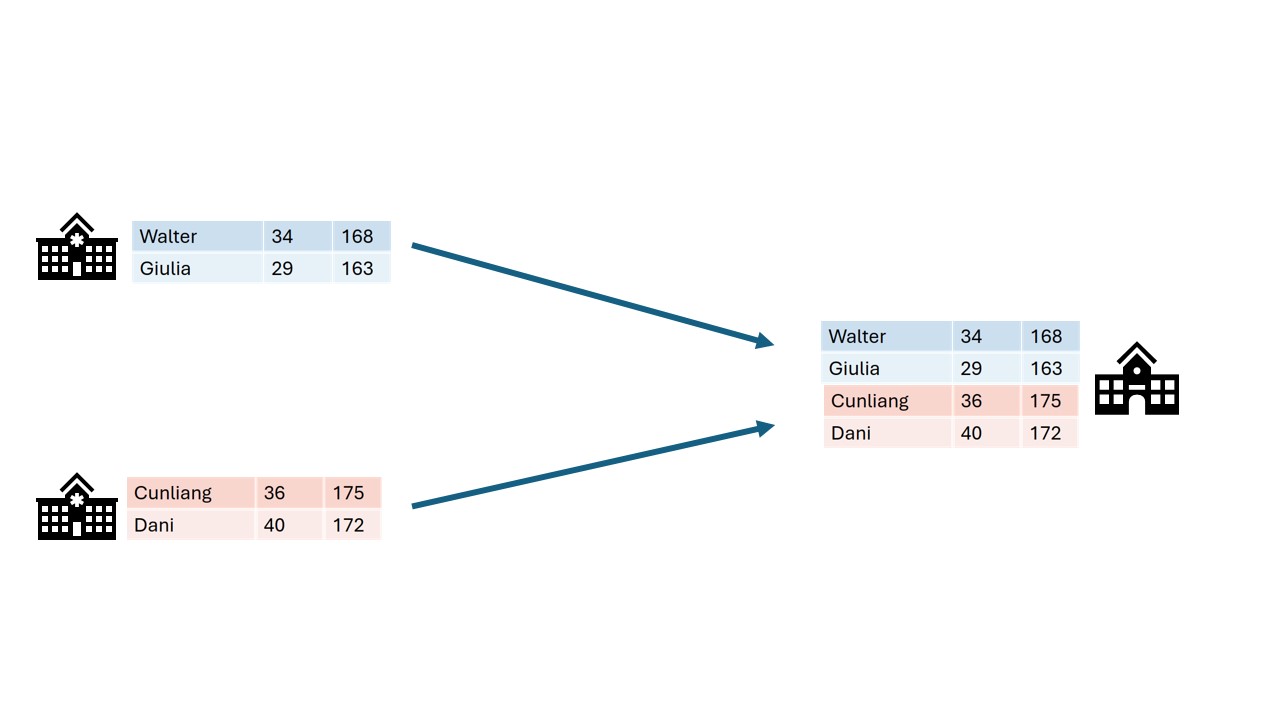
Unfortunately this way of working does not respect the privacy of the people contained within the dataset. All their personal details end up at another party.
1. Other problems with copying data
There are other issues with copying data to a central place that are not directly related to privacy. Some examples:
- The original data owner loses control of the data
- Results in multiple versions of the data
- What to do when the data needs to be updated?
- If there was consent in the first place, how can you retract consent?
1. Data sharing story time
Now it’s your turn. Have you personally experienced any issues doing research with data collected into a central place? Discuss with your peers.
In this lesson, we will discuss various privacy-enhancing technologies (PET) that can be used to analyze data in a privacy-preserving manner, and what the risks associated with different technologies are.
Data anonymization and pseudonymization
The first step in the process is often data anonymization. Personal identifiable information will in this case be removed so that individuals stay anonymous. Data pseudonimization is a similar process, but in this case, the records will be assigned an id that will make it possible to link individuals across datasets.
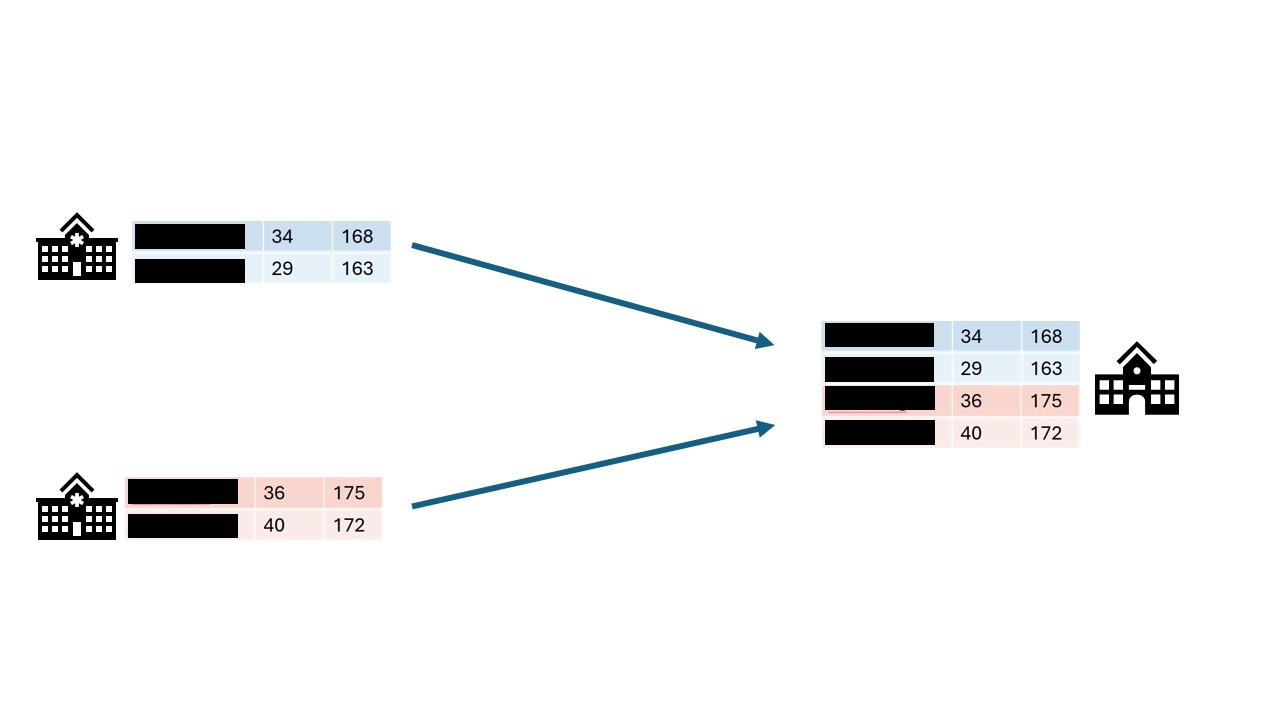
While data anonymization and pseudonymization are often a good first step, there is no guarantee that the data will never be reidentified. A famous example of reidentification is the story of the Netflix prize. The Netflix prize was an open competition to build the best recommender system to predict user ratings for films based on previous ratings. The data was anonymized, but in 2007 two researchers from The University of Texas at Austin were able to identify a large number of users by matching the dataset with film ratings on the Internet Movie Database (IMDB).
Federated data analysis
There are different ways in which privacy risks can be mitigated. For example, a well-known technique is to send the data to a trusted third party (TTP). The data can then be analyzed at that location in a traditional way. However, there are issues with this technique. When the data is copied to the TTP, the original owner loses control over it. Another issue with it is that this technique results in a single point of failure. If the security at the TTP is breached, all the data it handled could be exposed.
In this course we will focus on federated analysis. In a federated setting, the data with the data owner, who keeps full control over it. In this case, it is not the data that travels, but the analysis itself. The system sends a query or instruction to the data and only the results will get back to the user. The results are often akin to a form of aggregation of the data. This can be in the shape of traditional statistics like the mean, or it can be more intricate like a machine learning model. When data is aggregated, it doesn’t have a direct link with an individual anymore. Since the aggregated data cannot be be traced back to individuals individuals directly, the privacy is considered protected.
Aggregating the data does not ensure complete protection of person-level information, but it certainly makes it less likely that this will happen. It is usually the case that the larger the dataset, the lower the risk of data leakage. For instance, if you would like to take the mean of all records that fit a certain requirement, like age > 90, and there happens to be only one records that fits the requirement, the aggregation will be equal to the one matching individual record.
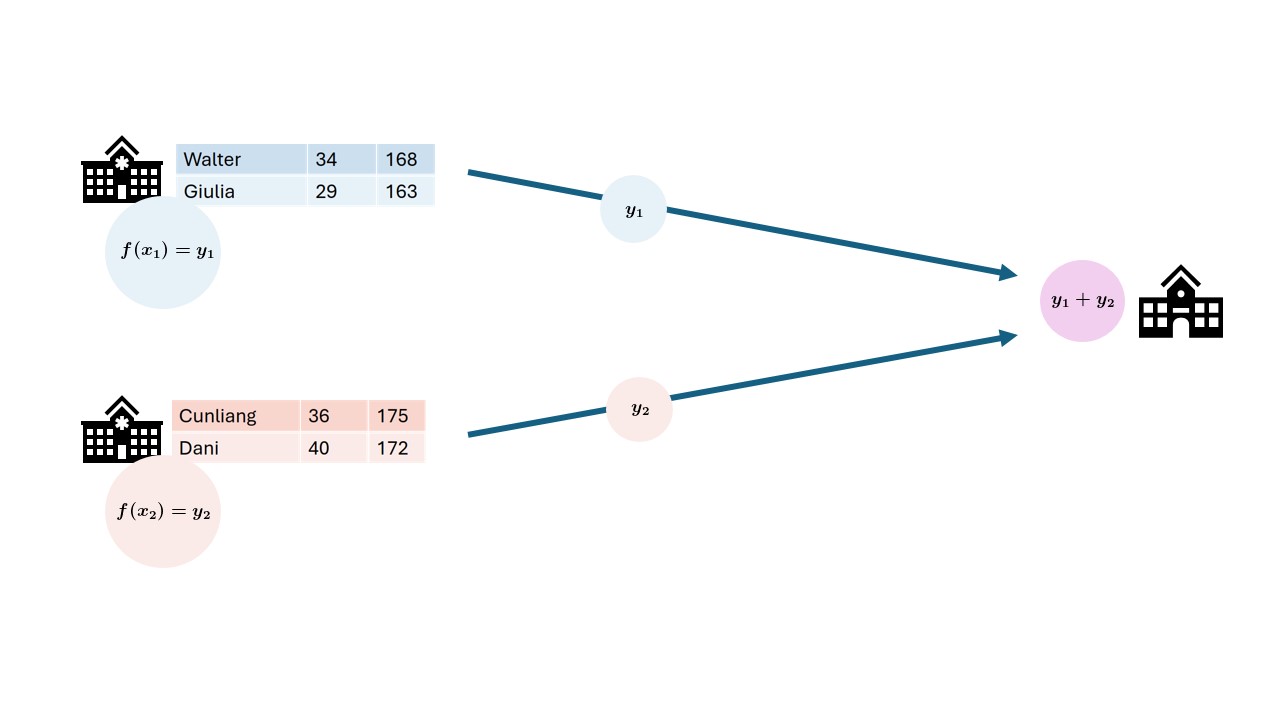
Federated learning
The term federated learning was introduced in 2016 by researchers at Google (McMahan et al.) and refers to a “loose federation of participating devices (which we refer to as clients) which are coordinated by a central server.” In traditional federated learning, the clients train machine learning models, and only the updates of the models are sent back to the central server. The central server combines the updates from all the individual clients into one final machine learning model.
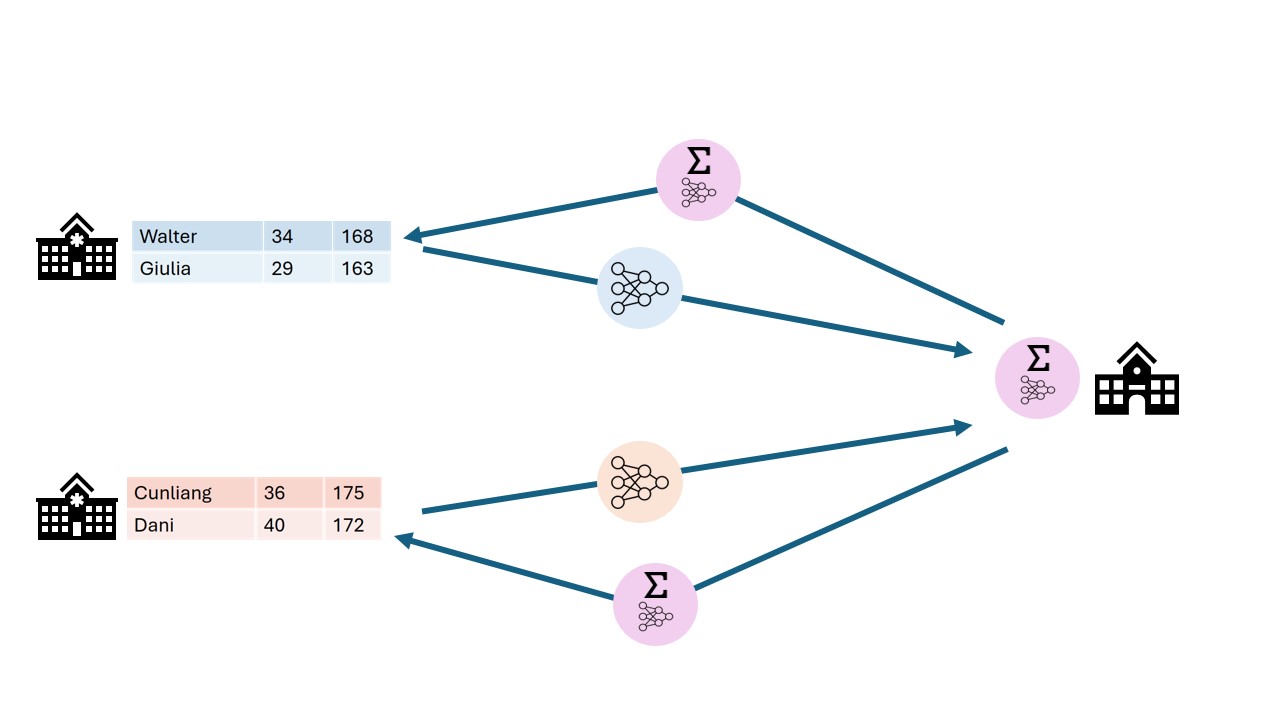
There are caveats to using this type of data analysis though. Although the data transmitted from the clients to the server are an aggregation of the raw data, researchers have found a way to use this data to reconstruct the original data. This vulnerability is called gradient leakage.
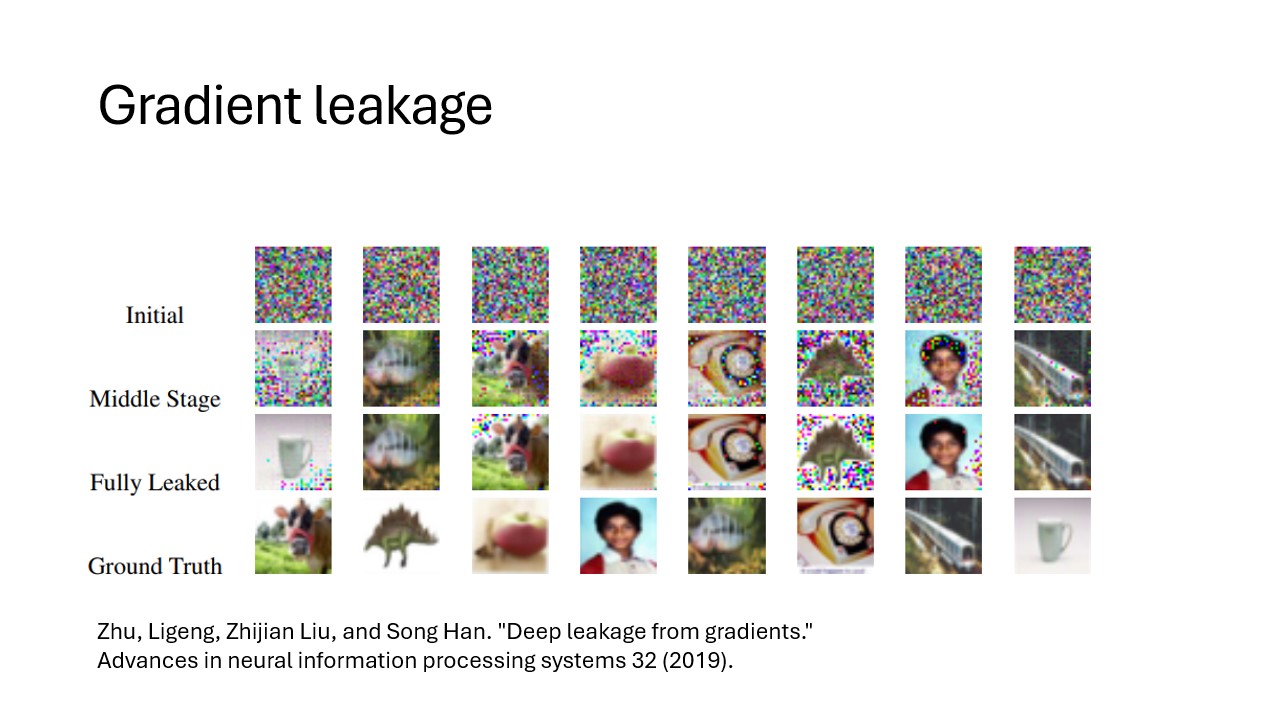
Secure Multiparty Computation
There are different solutions to prevent the reconstruction of raw data. One solution is to make sure that no party other than the data owner is actually able to see the intermediate data. One branch of techniques that can be used for this is Secure Multiparty Computation (MPC). With MPC, computations are performed collaboratively by multiple parties. Data is encrypted in such a way that other parties cannot see the original values, but values of multiple parties can still be combined ( e.g. added or multiplied). A classic technique from the field of MPC is secret sharing. With this technique data is encrypted, after which pieces of the encryption are sent to the other parties. No single party will be able to reconstruct the original value. Only when a certain minimum of parties work together (n-1 in many cases) the original value can be retrieved.
When combining multiple values using secret sharing, this will result in the parties owning new puzzle pieces that when put together will reveal the result of the computation.
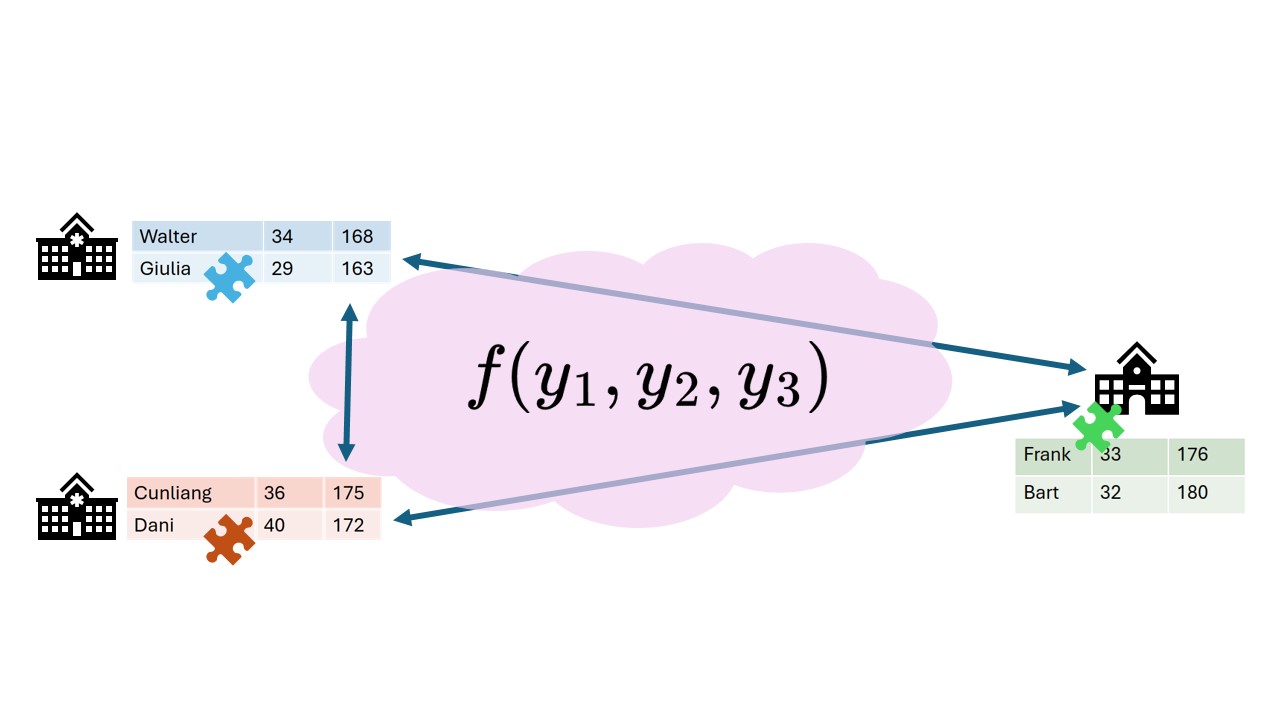
Secret sharing, an example
Mees, Sara and Noor want to know how much they weigh in total. Mees weighs 43 kg, Sara weighs 39, Noor weighs 45. All three they think of 2 random numbers \(r_1\) and \(r_2\) so that \(weight = r_1 + r_2 + x\). Finally they compute \(x\) by \(x=weight - r_1 - r_2\). These random numbers can be seen as encrypted data.
After computing the secret shares, they distribute these “cryptographical puzzle pieces” among their peers.
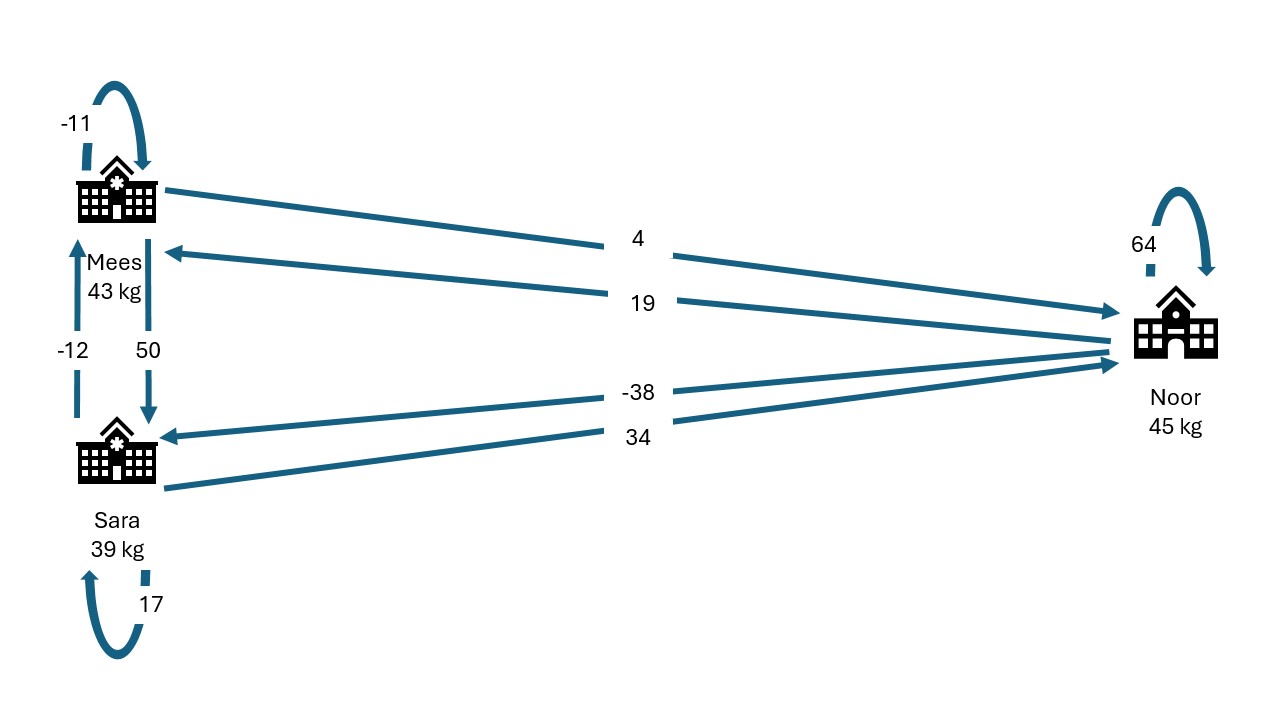
| Mees receives | Sara receives | Noor receives | Sum | |
|---|---|---|---|---|
| Mees generates: | -11 | 50 | 4 | 43 |
| Sara generates: | -12 | 17 | 34 | 39 |
| Noor generates: | 19 | -38 | 64 | 45 |
They sum their shares:
| Mees | -4 |
| Sara | 29 |
| Noor | 102 |

They add their sums together: -4 + 29 + 102 = 127 In this way, they have aggregated their data without sharing their individual data with anyone else.
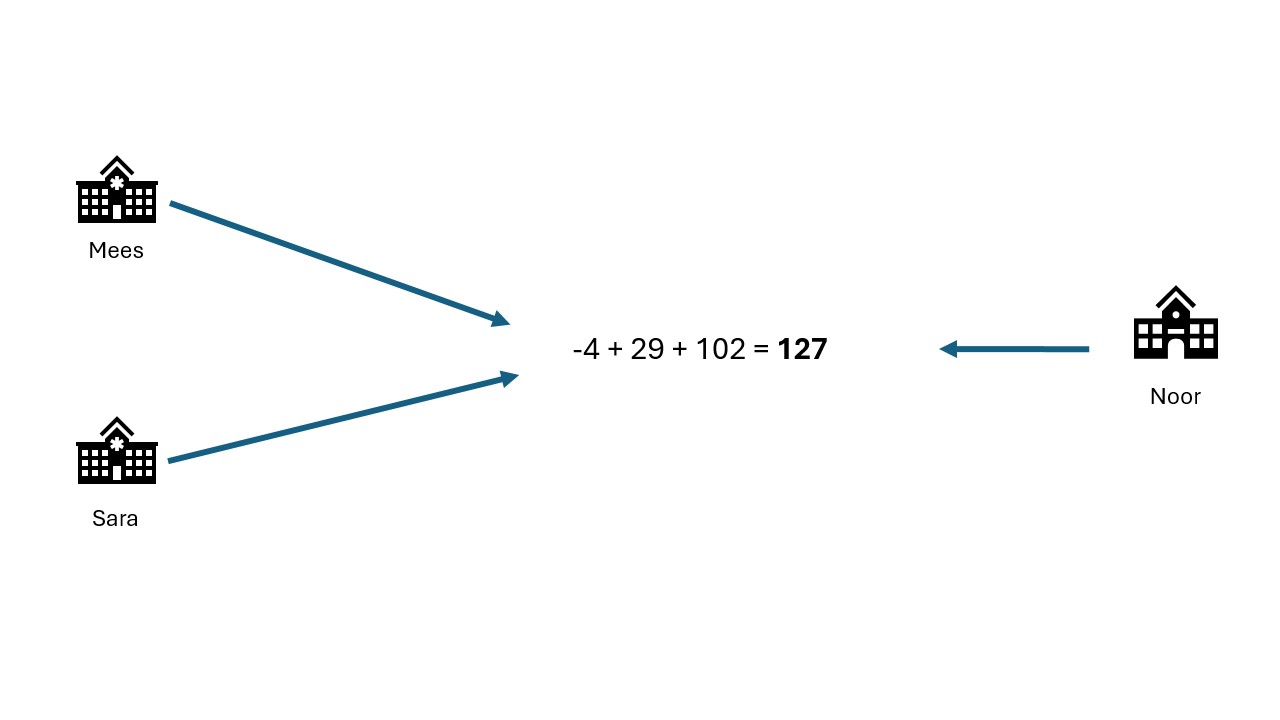
Oh no! A hacker!
A hacker manages to get access to Mees’ computer that contains his data and the secret shares he received. He also knows the result of the aggregation. Will the secrecy of the three weights still be preserved? What if the hacker gets access to Sara’s computer as well? Will Noors privacy be protected?
If the hacker has access to the result, he can reconstruct Noors weight by subtracting Mees’ and Sara’s weight from the total. The secret shares are not adding any more relevant information.
3. Aggregation preserves privacy?
Consider the dataset with the 3 childrens weights again. The only unencrypted data everybody receives, is the result. Consider the situation where Sara knows Mees very well, and might know approximately how much he weighs. Do you think the privacy of the three individuals is properly preserved?
When receiving a sum from a set of 3 individuals, every record makes up roughly 30% of the final answer. That is a big contribution. It can be quite easy to reconstruct the individual records, for example by crossreferencing with other datasets. Also, if you are able to get your hands on 2 of the datapoints, you will be able to fully reconstruct the third one.
Usually there are guard rails in place when performing PET analysis to reject situations where there are very few datapoints, because the original data is too easy to reconstruct.
Trust is another factor here. If the different parties (Mees, Sara and Noor) have a high level of trust in eachother not to share their data, the risk level is lower than when the parties are known to occasionally leak their data, or don’t have proper security set in place.
Differential privacy
As mentioned before, aggregation of data will not always prevent leaks of sensitive information. Consider the example of Mees, Sara and Noor. We know their total weight is 127 kg. If Sara and Noor get together and subtract their weights off of the total, they will be able to infer how much Mees weighs.
An aggregation is fully differentially private when someone cannot infer whether a particular individual was used in the computation. In the field of differential privacy there are different techniques for adapting analyses to be more differentially private. Often these techniques involve adding noise to either the raw data or the result of the analysis. This makes the result less precise, but with the added benefit that it will be more difficult to infer the original data.
The figure below shows a differential privacy technique where a random subset of the data is replaced with random values. This gives an individual plausible deniability regarding whether they were part of the original dataset. Their data might have been used, or it might have been replaced with noise.
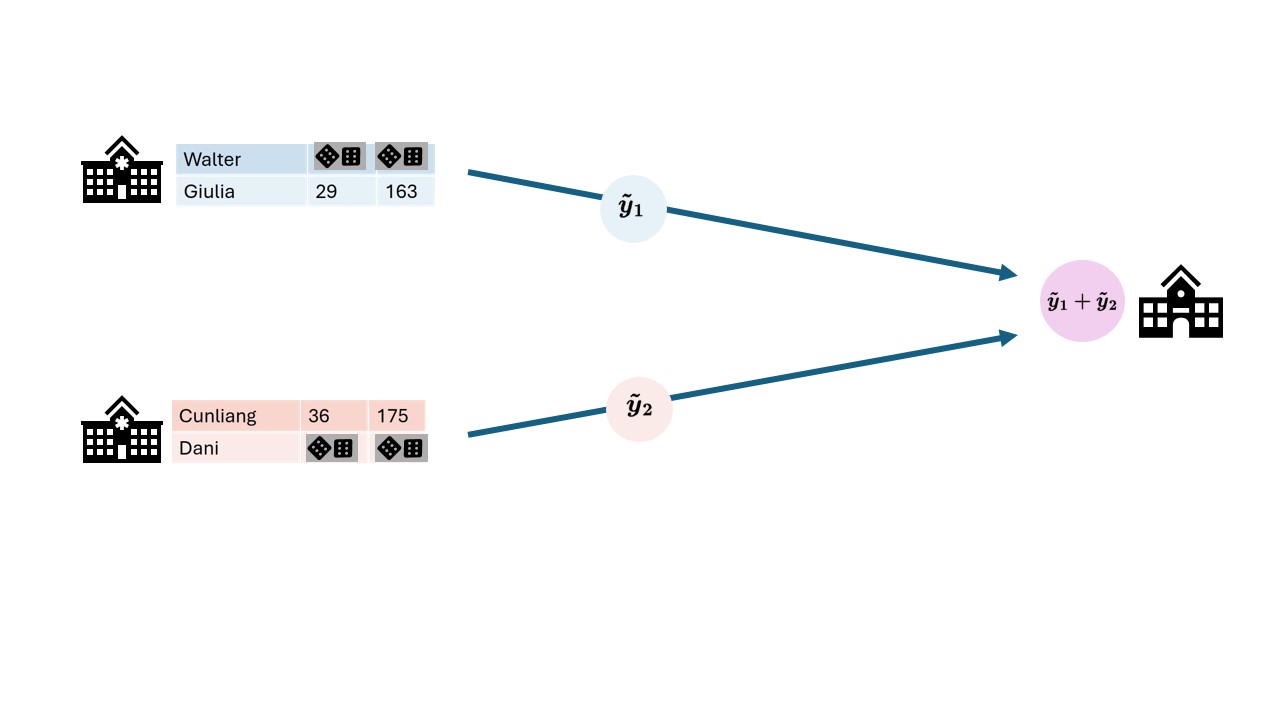
Blocks upon blocks
The previously mentioned techniques are not used in isolation, but are usually stacked on top of eachother to mitigate the privacy risks that are relevant within the usecase. Typically, the process begins by anonymizing or pseudonymizing the data. With vantage6, the data is then placed in a federated setting. Then, the data is analyzed using federated learning, which may also include, for instance, MPC protocols to further safeguard data privacy. Additionally, noise may be added to the raw data as well before it is analyzed, using techniques from differential privacy.
Data partitioning
Data sharing challenges come in many different shapes and sizes, but in the end, the goal of the researchers is often to analyze data as if it were available in one big table in one place. There are 2 main ways in which the dataset can be separated over different sources: horizontal and vertical partioning.
In horizontal partitioning, this giant table has been snipped in pieces by making horizontal cuts. The result is that information of an individual record will stay in one place, but the records themselves have been scattered around in different locations. A common example of horizontal partitioning is when different hospitals have the same data on different patients.
In vertical partitioning, the cuts have been made vertically. Columns have now been divided over different locations. For example, this would be the case if a hospital has data on a set of patients and the GP has different information for the same set of patients. This type of partitioning is usually more challenging because often a way needs to be found to link identities across datasources. Vertical partitioning requires different types of privacy enhancing algorithms than horizontal partitioning.
Data can even be horizontally and vertically partitioned at the same time. In these cases, it may be necessary to combine multiple techniques. For example, you might want to combine census data with medical records from hospitals. This is vertically partitioned because the census and medical features are stored in different places. On top of that, you might want to combine multiple hospitals, that all store their records separately. Since the medical records are physically separated as well, it is horizontally partitioned.
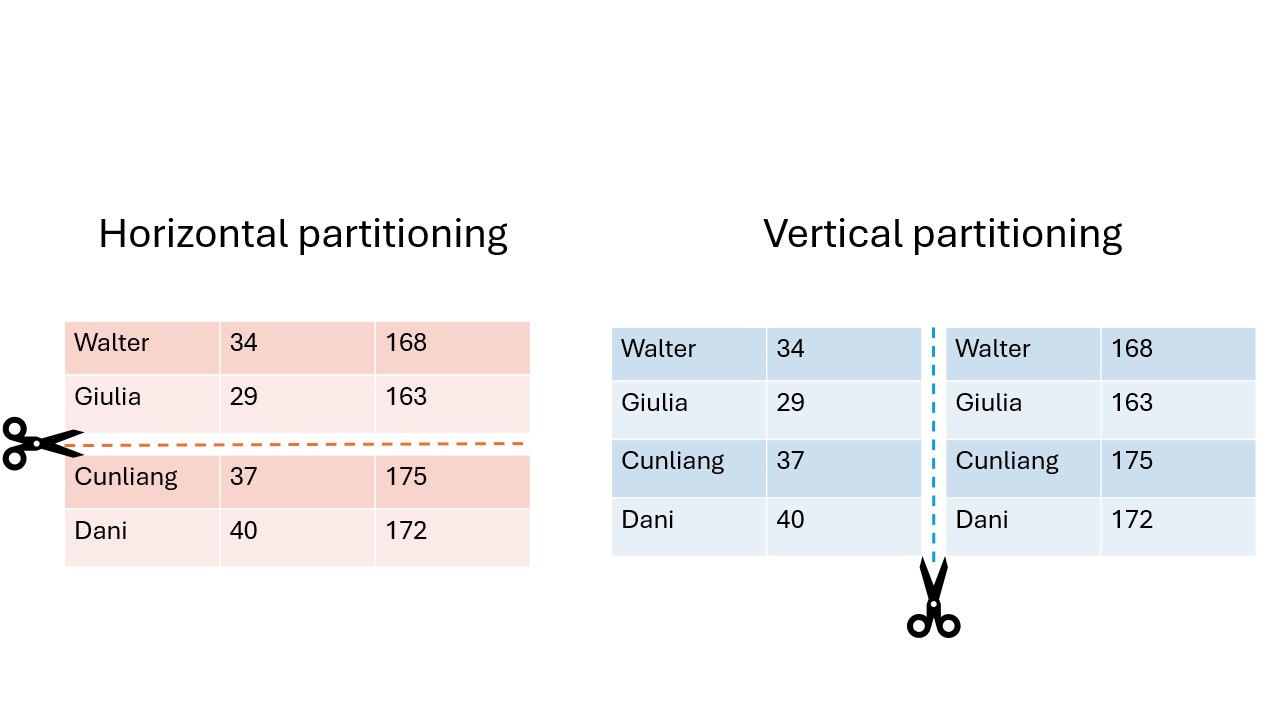
Technology doesn’t solve everything
You have now learned about various technologies for analyzing data while preserving privacy of individuals. However, it should be emphasized that these technologies do not solve all your data sharing problems. Rather, they are only a small piece of the puzzle. In research projects involving privacy enhancing technologies, a lot of work goes into complying with regulations and building trust.
Since these projects have a risk of affecting the privacy of individuals, a Data Protection Impact Assessment (DPIA) is usually required. This is a process that will help identify and minimize privacy risks of a project and is required by the GDPR. There is already a DPIA available for vantage6
Apart from procedures required by GDPR there might be other regulations in place enforced by the owners of the data (e.g. hospitals). For healthcare specifically there will be the European Health Data Space (EHDS). EHDS builds upon the GDPR and ensures the exchange and reuse of healthcare data in a safe and secure way.
The specific situation of a project can affect the way in which the data is allowed to be processed. Some privacy enhancing technologies might be allowed in one project but prohibited in another. It is always important to stay transparent about privacy risks of the technologies you intend to use.
Another factor in performing PET analysis is data harmonization. All parties need to make sure that their data is in the right shape to be combined. For instance, if you have two datasets where one stores the height of patients in a column “height” in centimeters, and another dataset where it is stored in meters in the column “patient_height” you cannot perform your analysis. You will need to make sure all datasets follow the same standards and schemas in order to process them together. There are a couple of datastandards out there to help you with that, such as OMOP CDM or FHIR together with SNOMED-CT.
In conclusion, PETs will help you to extract valuable insights from sensitive data, but they are only one aspect of the process. It is also important to consider other factors such as regulations and data preprocessing.
- Privacy enhancing analysis can derive insights from data without seeing individual records.
- Privacy enhancing analysis usually starts with the anonymization or pseudonymization of the data.
- In federated data analysis the analysis moves to the data, while in classic analysis the data moves around.
- In secure multiparty computation, computations are performed collaboratively without any one party being able to see all the raw data.
- Techniques from differential privacy add noise to the data to make it harder to reconstruct the original records from an aggregation.
- Privacy enhancing analyses usually stack multiple techniques on top of each other to provide multiple layers of protection.
- Horizontal partitioning means the records are split, while in vertical partitioning the features are split.
- Technology is only one part of the story, when doing research on privacy sensitive data.
